2025 Traction and Portable Engines
R. Wolf Portable Semi Portable Steam Engine
Manufacturer R.: Wolf Portable Semi Portable Steam Engine
Year of Manufacture: 1899
Country Assembled: In Magdeburg – Buckau Germany 1899
Manufactures: Number 7332
Size Nominal: Horse power 5 hp
Number of cylinders: 1
Fuel used: Coal wood
Boiler Pressure: 100psi original 45 psi current
Water capacity: 200 litres
Boiler Type: Fire tube boiler
Weight of Engine: 2.25 tons
Owned By: Robert Newbigging
Location: Telegraph point
Restored By: By self
History of Ownership: It came from a Germany Naval Vessel WW1 it was used as a winch to raise and lower the anchors there were two fitted to the ship The ship was dismantled in Melbourne and the semi portable engines removed and sold Dr Fitzpatrick from Walcha used the engine to a run a woolshed until 1930 when electricity arrived it was sold to a Mr Wall Who used it to power a docking saw at his sawmill until 1947 Robert Newbigging purchased it in 2000and had it running by 2004
Used to: Operated anchor winches

Marshall Sons & Co Ltd Britannia Iron Works, Gainsborough, England
Manufacturer: Marshall Sons & Co Ltd Britannia Iron Works, Gainsborough, England
Year of Manufacture: 1907
Country Assembled In: England
Manufactures Number: 5555
Size Nominal: Horse power 6 NHP
Number of cylinders: Single cylinder double acting 8” Bore 10”Stroke
Type of boiler: Locomotive
Boiler pressure: 100 PSI
Fuel used: Wood
Weight of machine: 4.5 ton
Owned By: Len Gaut
Location: Mulbring
Restored By: J. Liddle of Duri 1980’s
History of Ownership: Current – Maitland City Council Previous
Description and Use: Used to operate a saw mill in the Forbes district NSW

Richard Garrett and Sons Leiston Works
Manufacturer: Richard Garrett and Sons
Leiston Works
Year of Manufacture: September or October 1864 Oldest surviving Garret portable in Australia
Country Assembled In: Leiston near Saxmundham, Suffolk
Manufactures Number: Eng no 2123
Size Nominal Horse power: 4 NHP
Number of cylinders: Single cylinder double acting 5 “ Bore 10 “Stroke
Type of boiler: Locomotive
Boiler pressure: Original 90 PSI
Fuel used: Wood
Weight of machine: 2 ½ ton
Owned By: Maitland Steam & Antique Machinery Association Inc
Location: Hunter Valley
Restored By: Display Engine only, front axle to be straightened. Painted with diesel engine oil to preserve it in its present state
History of Ownership: Gold Mine Fosterton north of (Dugong)
About 10.2km north of Dungog and 7km north-north-west of the Rocky Hill Mine, is the Fosterton Mine (55) [GR 47730050]. The workings comprising of shafts and shallow pits of unknown dimensions were sunk on a quartz vein lying in a shear zone surrounded by pebbly feldspathic sandstone. Nothing further is recorded.
Description and Use: Engines of this type which combined a light weight engine and boiler drove pumps Chaffcutters, agriculture machinery, pumps and ore crushers
This machine drove an Ore crusher at a gold mine located in the Dungog area
It was buried under a rock fall. The damage to the front axle occurred when it was removed with a Bulldozer.

TAR POT
Manufacturer: Weeks and Son LTD Maidstone, Kent UK
Year of Manufacture: Circa 1028
Country Assembled In: Perseverance Iron Works England
Fuel used: Coal fired Tar sprayer
Boiler Pressure: Open to atmosphere
Tar capacity: 100 gallons
Boiler Type: Single grate underfired
Weight of Engine: 1 Tonne
Owned By: Maitland Steam & Antique Machinery Association
Location: Maitland
Restored By: Unrestored
History of Ownership: Believed to have been purchased by the Sydney Municipal Council. Passed to Trevor Gaut and donated it to Maitland Steam by Reverie Iron Works
Used to: Used to spray tar onto gravel road surfaces, which were then finished by a steam roller

Marshall and Sons Gainsborough England
Manufacture: Marshall and Sons Gainsborough England
Country Assembled In: England
Manufactures Number: 8821
Type of Boiler: Locomotive
Fuel Used: Wood
Boiler pressure: Design 120PSI
Weight of engine: 4.5 tonne
Owned By: Maitland Steam & Antique Machinery Association
Location: Maitland
Restored By: To be restored at a later date if anyone knows of parts that will suit this machinery, please contact us on 0428396849.
History of Ownership: The engine was imported by Alfred Shaw and Coy agent for Marshall engines. Engine build register is number 12. The engine was purchased by Warwick Peel of Spring Ridge of NSW and subsequently purchased by Maitland Steam & Antique Machinery Association ion for future preservation This engine has an identical engine number 8827.
Used to: It is believed to have operated a drill rig in the Burke area

Marshall Sons & Co Ltd
Manufacture: Britannia Iron Works, Gainsborough, England
Country Assembled In: England
Manufactures Number: 19385
Type of Boiler: Locomotive
Fuel Used: Wood
Boiler pressure: Original 120 PSI
Current 75 PSI
Weight of engine: 4.5 tonne
Owned By: Maitland City Council
Location: Hunter Valley
Restored By: Current – Maitland City Council
Previous
Description and use: Engines of this type which combined a light weight engine and boiler drove pumps Chaffcutters and other agriculture machinery
They were called portable because they could be carted easily around the country side as needed
Restoration works by MS&AMA:
Re-tubed by club
Governor Re built
New Piston Rod fitted
New Piston and Rings
Lubricator rebuilt
New ash pan 2019
New council emblem mounting timbers 2019
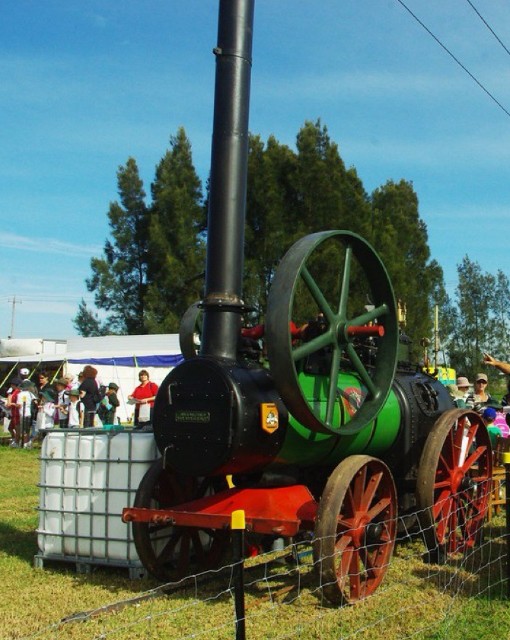
Robey & Co Ltd of Lincoln
Manufacture: Robey & Co Ltd of Lincoln
Country Assembled In: England
Manufactures Number: eng no 30168
Type of Boiler: Robey locomotive firebox portable
Fuel Used: Wood
Boiler pressure: Original 110 PSI
Current 90PSI
Weight of engine: 4 tonne
Owned By: Wayne Gray
Location: Hunter Valley
Restored By: Wayne Gray
History of Ownership: The engine came from the Woodstock shearing shed
Property name “Underwood
Description and use: Engines of this type which combined a light weight engine and boiler drove pumps Chaffcutters and other agriculture machinery
They were called portable because they could be carted easily around the country side as needed.
History: Robert Robey started business in 1854, manufacturing portable steam engines and thrashing machines. His range of agricultural equipment rapidly expanded; in the Great Exhibition of 1862 “fixed engines, traction engines, ploughing tackle, corn mills, saw benches etc” were on display and soon a complete range of mining equipment was on offer from winding and pumping engines to locomotives, cages and kibbles.
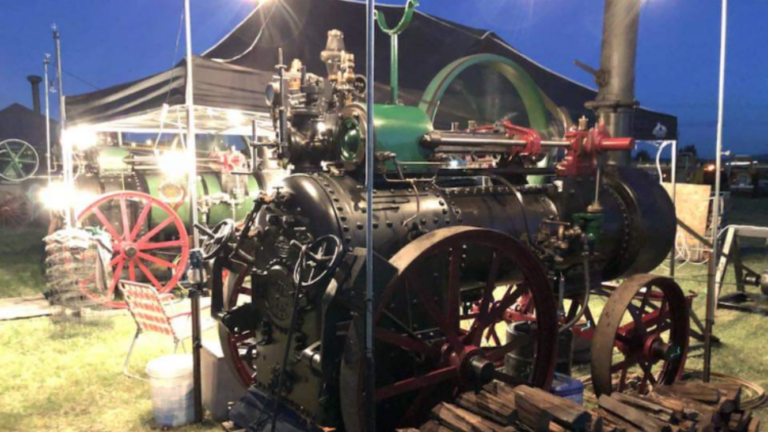
Aveling and Porter of Rochester in Kent
Year of Manufacture: 1920
Country Assembled In: England
Manufactures Number: 9247
Type of Boiler: Belpair Locomotive type
Fuel Used: Coke /coal
Boiler pressure: 200 psi
Weight of engine: 6.6 tonne
Owned By: Museum of applied arts and science
Location: Sydney
Restored By: Museum of applied arts and science.
History of Ownership: Rockdale Council It is rare as only 3 are left in the world and it was used for carting gravel to make roads in Rockdale municipality
Description and use: Use to cart rock blue metal and Sandstone for road and gutter building.

Robey & Co
Year of Manufacture: 1910
Country Assembled In: England
Type of Boiler: Locomotive Type
Fuel Used: Wood
Boiler pressure: Original 120 PSI
Current 80 PSI
Weight of engine: 12 tonne
Owned By: Maitland Steam & Antique Machinery Association
Location: Hunter Valley
Restored By: Alan Simpson addition feed water line has been fitted to allow water to be pumped into boiler via an Economiser
History of Ownership: Alan Simpson
Tingha Tin Mine
Description and use: This Machine was used to drive ore crushers and water pumps used in a Tin Mine at Tingha
The water pumps operated at around 35psi the water was pumped through pressure nozzles to remove materials from the mine this was called Hydraulic Mining
History: Robert Robey started business in 1854, manufacturing portable steam engines and thrashing machines. His range of agricultural equipment rapidly expanded; in the Great Exhibition of 1862 ” fixed engines, traction engines, ploughing tackle, corn mills, saw benches etc” were on display and soon a complete range of mining equipment was on offer from winding and pumping engines to locomotives, cages and kibbles.
Imported into Australian by agent, Arthur Leplastrier & Co. of Sydney.

Buffalo Pitts
Year of Manufacture: 1906
Country Assembled In: USA
Manufacturers Number: 8728
Type of Boiler: Wet bottom boiler, fire box (33”h x 22”w x 32”l) 4.88 sq. ft grate
Tubes – 32 off x 2” Ø x 60” long.
Large heating surface (106 Sq. ft.) makes for very free steaming
Fuel Used: Wood Straw
Boiler pressure: The boiler was inspected and given a 110 psi ticket (originally 135 PSI when new 100 years ago).
Weight of engine: 3 tonnes
Owned By:Paul Debono
Location: Hunter Valley
Restored By: Brendan Brady and friends
History of Ownership: This engine was recovered from the Dorrigo area and may have been used in the saw milling industry.
By 1986 it was restored and being used for cutting firewood in a back yard in Hornsby.
Description and use: Portable steam engines were used as a portable power source for driving a range of machinery in both industrial and agricultural settings. For example and engine like this could have driven a saw bench, irrigation pump, threshing drum, engineering workshop etc. Portable engines are designed to be drawn from job to job by a horse or bullock team. As can be seen on this example, the team driver had a commanding, if somewhat precarious perch.

Richard Hornsby & Sons Grantham England
Year of Manufacture: 1903
Country Assembled In: England
Manufacturers Number: 8780
Type of Boiler: Fire tube
Fuel Used: Wood
Boiler pressure: Original 90 PSI
Current 90 PSI
Weight of engine: 5 tone
Owned By: The Brady Bunch
Location: Campbelltown
Restored By: Brendan Brady and friends
History of Ownership: Worked a shearing shed at Dunedoo Near Dubbo
1903 to 1920.
Description and use: Steam engines of this type drove pumps chaffcutters, saw mills, mining equipment and other agriculture machinery.
They were called portable engines as they could be transported to different locations by means of horses, mules and oxen teams.

Marshall Sons Gainsborough
Year of Manufacture: November 1913
Country Assembled In: England
Manufacturers Number: 62517
Type of Boiler: Fire tube
Fuel Used: Wood
Weight of engine: 11.5 tone empty
Owned By:Brady Family
Location: Original working location Tasmania and is now located in Sydney
Restored By: Marshall traction engine 62517 is in a unrestored condition.
History of Ownership: Marshall traction engine 62517, nominal erecting date 29/10/1913 was part of an order of four engines placed A. G. Webster Agents Hobart.
D. W. Bowman Cheshunt, commissioned an owner’s plate for the side of the tender ex works. The engine remained with D. W. Bowman until 1922 where it was acquired by C. Richardson and Sons. The engine then went to R. Geard of Pawtella and was later purchased by Ray Millington who shipped it to Sydney.

Bufflalo Pitts
Year of Manufacture: 1912
Country Assembled In: USA
Type of Boiler: Locomotive
Fuel Used: Wood
Weight of engine: 8.5 tons
Owned By: Alan Simpson
Location: Tamworth
Restored By: Alan Simpson purchases in 1975 restoration completed in 1988.
Used to: The traction engine was used to operate the Upper Horton Mill and attend to yard duties as required

Ruston Proctor Co
Manufacturer: Ruston Proctor Co Ltd of Lincoln UK at the company’s Sheaf Iron Works in Lincoln.
Year of Manufacture: 1913
Country Assembled In: England
Type of Boiler: Fire Tube
Fuel Used: Wood and Coal
Owned By: Jim & Lyndle Hawkes
Location: Kurri NSW
Restored By: Current owners and took over 6 years. The boiler work was completed by Ken Ainsworth of Goulburn.
Description of Use: The Ruston (known as Reverie) is an 8nhp double crank compound 2 speed agricultural traction engine. These engines were designed for mainly agricultural purposes such as powering (via a flat belt) threshing drums, chaff cutters, sawmills, pumps and land clearing.
This engine is also fitted with a winch that could be used to pull logs out of the bush and itself out of bogs. Water is carried in the rear tender and in a belly tank that is suspended under the boiler. Fuel is carried in the coal bunker that is located at the rear of the engine.
Timber is carried in the steel basket that hangs over the rear of the engine.
Maximum road speed is 4 miles per hour.
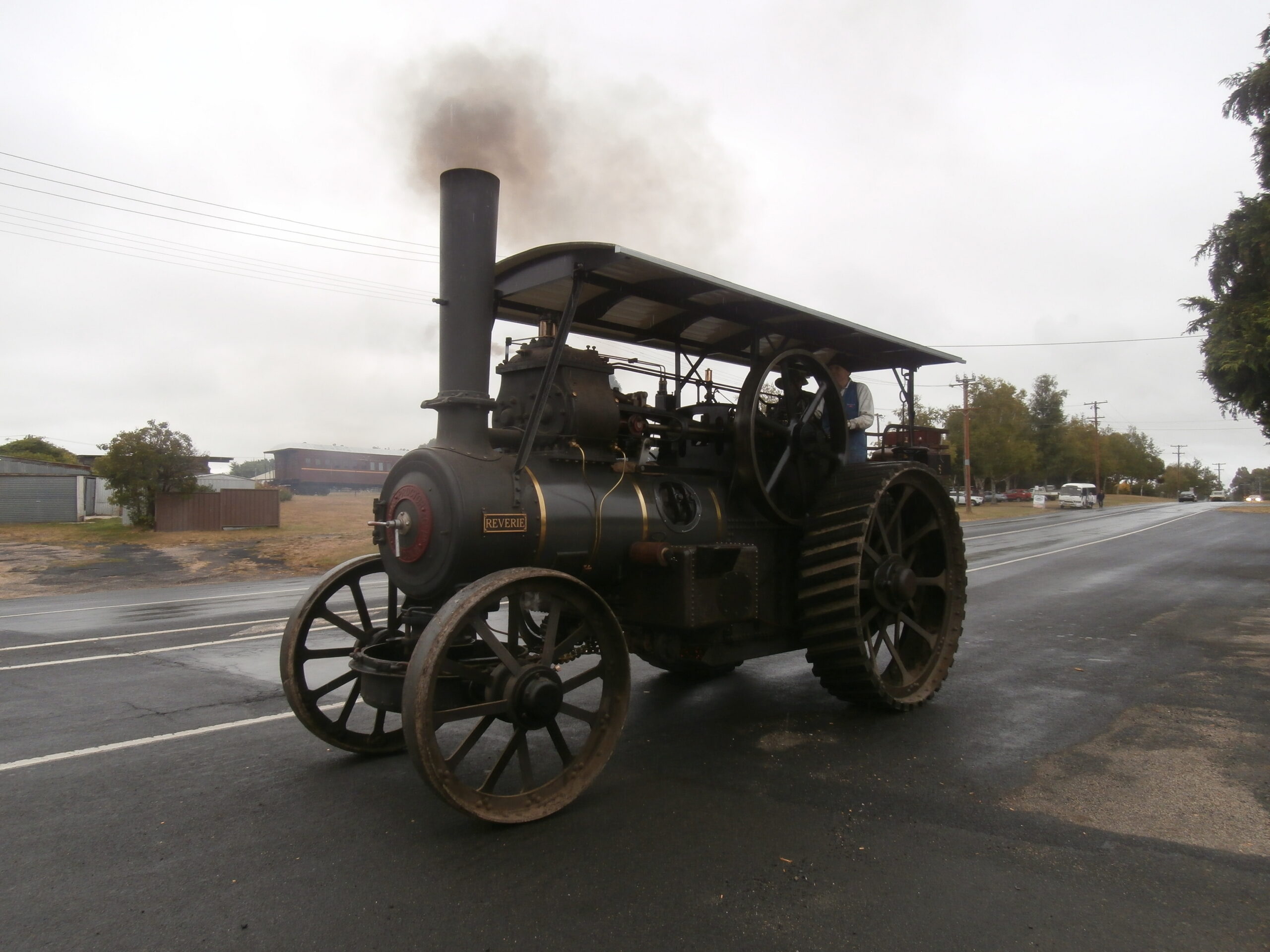
JIM HAWKS
Manufacturer: Ruston Proctor Co Ltd of Lincoln UK at the company’s Sheaf Iron Works in Lincoln.
Year of Manufacture: 1913
Country Assembled In: England
Type of Boiler: Fire Tube
Fuel Used: Wood and Coal
Owned By: Jim & Lyndle Hawkes
Location: Kurri NSW
Restored By: Current owners and took over 6 years. The boiler work was completed by Ken Ainsworth of Goulburn.
Description of Use: The Ruston (known as Reverie) is an 8nhp double crank compound 2 speed agricultural traction engine. These engines were designed for mainly agricultural purposes such as powering (via a flat belt) threshing drums, chaff cutters, sawmills, pumps and land clearing.
This engine is also fitted with a winch that could be used to pull logs out of the bush and itself out of bogs. Water is carried in the rear tender and in a belly tank that is suspended under the boiler. Fuel is carried in the coal bunker that is located at the rear of the engine.
Timber is carried in the steel basket that hangs over the rear of the engine.
Maximum road speed is 4 miles per hour.

SOOTY
Manufacturer: Fowler built-in leads
Year of Manufacture: 1326
Country Assembled In: England
Type of Boiler: Fire Tube
Fuel Used: Wood and Coal
Owned By: J Preston
Weight of machine: 10 tonnes
Size Nominal Horsepower: 4NHP
Location: Wellington, NSW
Restored By: John Preston
Repairs carry out since Steamfest 2016.
- New front rubber tyres fitted
- New fusible plug fitted
- New washout plugs fitted
- New drain cock values cylinder chest
- Rebuilt eccentrics
- Belly tank was internally blasted and painted
History of Ownership: Purchased to the Camden City Council
Description of Use: Sooty is a Fowler Convertible Traction engine. The front wheels can be replaced with a solid roller to convent it from a traction engine to a steam roller. This engine is also fitted with a winch that could be used to pull logs out of the bush. Water is carried in the rear tender and in a belly tank that is suspended under the boiler. Fuel is carried in the coal bunker that is located at the rear of the engine. Timber is carried in the steel basket that hangs over the rear of the engine.
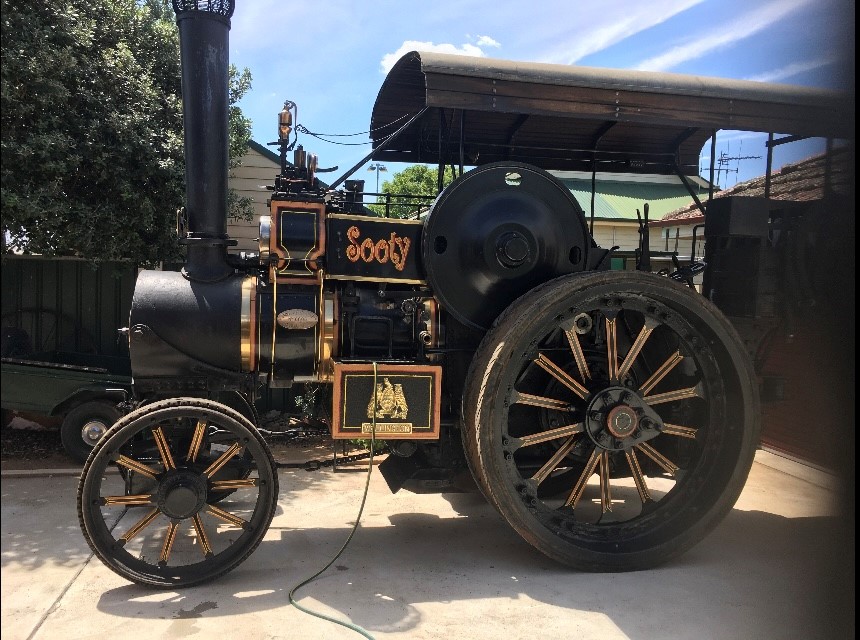
Ruston Proctor
Manufacturer: Ruston Proctor Co Ltd of Lincoln UK at the company’s Sheaf Iron Works in Lincoln.
Year of Manufacture: 1910
Country Assembled In: England
Type of Boiler: Fire Tube
Fuel Used: Wood
Owned By: Steven King
Location: Glen Innes, NSW
Restored By: John Gotts, Scoresby. Further work by current owner will include restoration of boiler cladding and full length canopy.
Description of Use: The “colonial type” was Ruston Proctor’s answer to competition from American manufacturers. It was lighter, with wide wheels, and easy rear access to the footplate making it suitable for ‘direct ploughing’. The use of a clutch in the smaller flywheel followed American practice, along with a longer fire box for burning wood.
This engine excelled at chaff cutting (up to 2 tons an hour) and would have towed the Bunting chaff cutter, steamer and cook house from farm to farm at it’s maximum speed of 2 mph. It was later used to drive a saw mill around which time the clutch was removed.
15 of the SHA class were imported into Australia by McKay’s of which only two others are known to have survived (41000 now owned by George Brown and 42028 owned by Neil Asplin) and if there are others the owner would be delighted to hear from you.

Marshall Sons and Company Ltd.
Manufacturer:Marshall Sons and Company Ltd.
Year of Manufacture: 1913
Country Assembled In: England
Type of Boiler: Fire Tube
Fuel Used: Wood and Coal
Owned By: David Toyne
Location: Oberon NSW
Restored By: The engine has never been derelict. David Von Stieglitz carried out some minor boiler work and gave her a coat of paint in 1971 in preparation for the Launceston Centenary Show.
Description of Use: Although dispatched in 1913, the engine wasn’t put to work until 1922. In that time it had travelled from England to New Zealand and then on to Tasmania. In 1922 it was acquired by Ned Peterson, A threshing and chaff cutting contractor in Westbury Tasmania. Ned was also an engine dealer.
The engine spent most of its short working life driving Walter’s sawmill, and then, for a short their stone crusher. It was laid up in the late 1950s.
Since the 1970s it has been rallied by the two preservation owners, David Von Stieglitz and David Toyne.
In 2017 the engine was taken out of service and stripped down to have a new firebox fitted by K & H Ainsworth of Goulburn. It returned to steam in 2022 with Steamfest Maitland being its first public event.
The engine carries the name Andora, which is the name of the property on which it resided for 45 years.
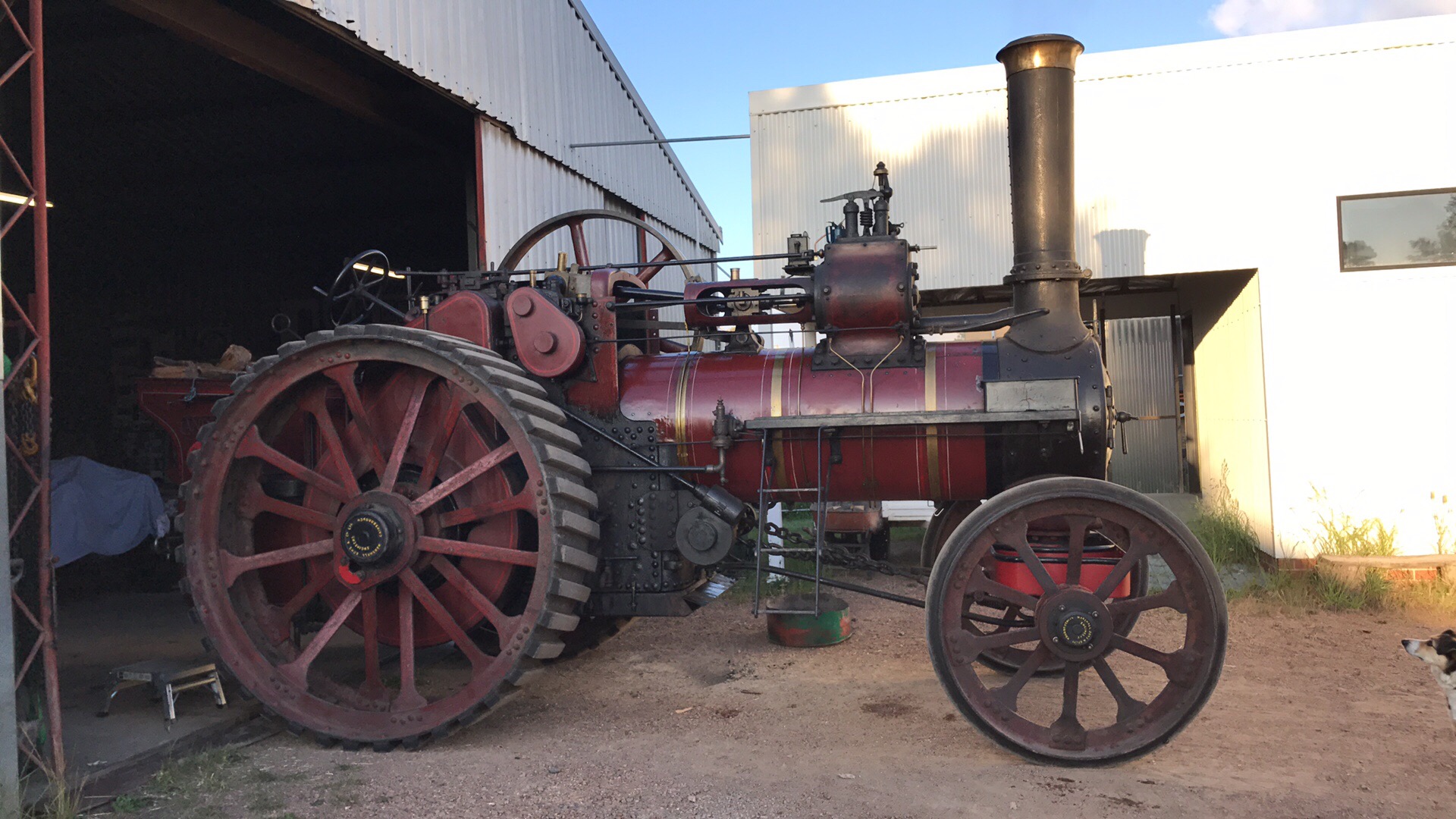
6HP Brittannia
Manufacturer: Marshall Sons & Co Ltd
Britannia Iron Works, Gainsborough, England
Year of Manufacture: 1907
Country Assembled In: England
Type of Boiler: Colonial
Fuel Used: Wood
Owned By: Antony Pritchett
Location: Hunter Valley
Restored By: David and Antony Pritchett
Description of Use: Engines of this type which combined a light weight engine and boiler drove pumps Chaff cutters and other agriculture machinery.
They were called portable because they could be carted easily around the country side as needed
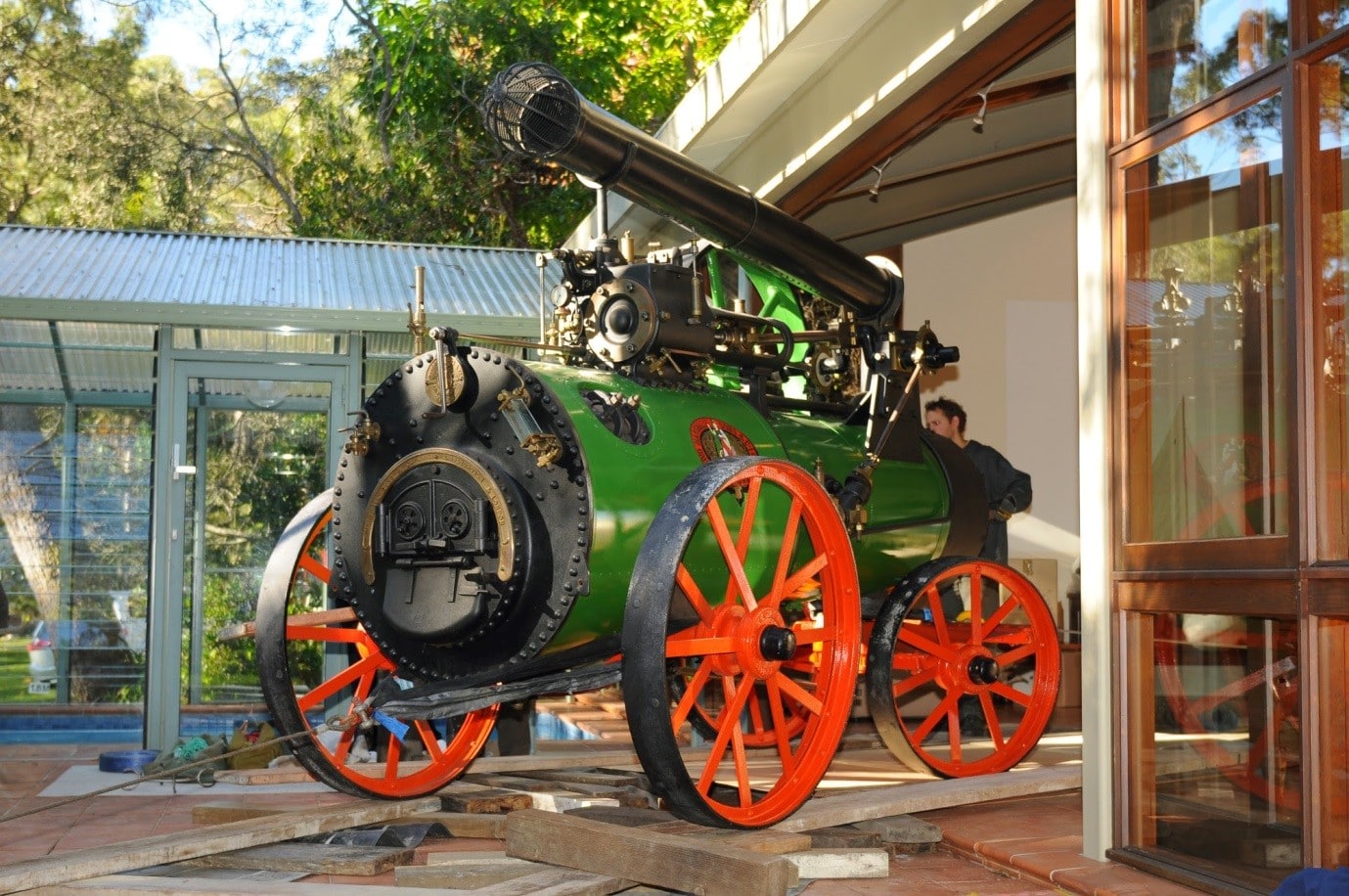
14 HP Marshall
Manufacturer: Marshall Sons & Co Ltd
Britannia Iron Works, Gainsborough, England
Year of Manufacture: 1911
Country Assembled In: England
Manufacturers Number: 46024 Engine Number 1004
Type of Boiler: Locomotive Type
Fuel Used: Wood
Owned By: Kelly and Peter Garnham
Location: Maitland NSW
Restored By: Peter Garnham and members of Maitland Steam and Antique Machinery Association
History of Ownership: Current – Garnham Family Purchased Feb 2017
Previous –2016 – 2017 Reverie Iron Works Oberon
1911 imported into Tasmania
1930 Purchased by Furney travelling Chaff Cutting. Then transported to Mainland and installed in Furney Factory Dubbo to supply steam to Factory. Removed from Factory and sat on Farm in Dubbo to rot.
2016 Rescued by Reverie Ironworks and transported to Oberon
2017 Purchased by Garnham Family with Purpose of restoration and Run in Maitland
Description of Use: Engines of this type which combined a light weight engine and boiler drove pumps Chaffcutters and other agriculture machinery.
They were called portable because they could be carted easily around the country side as needed.
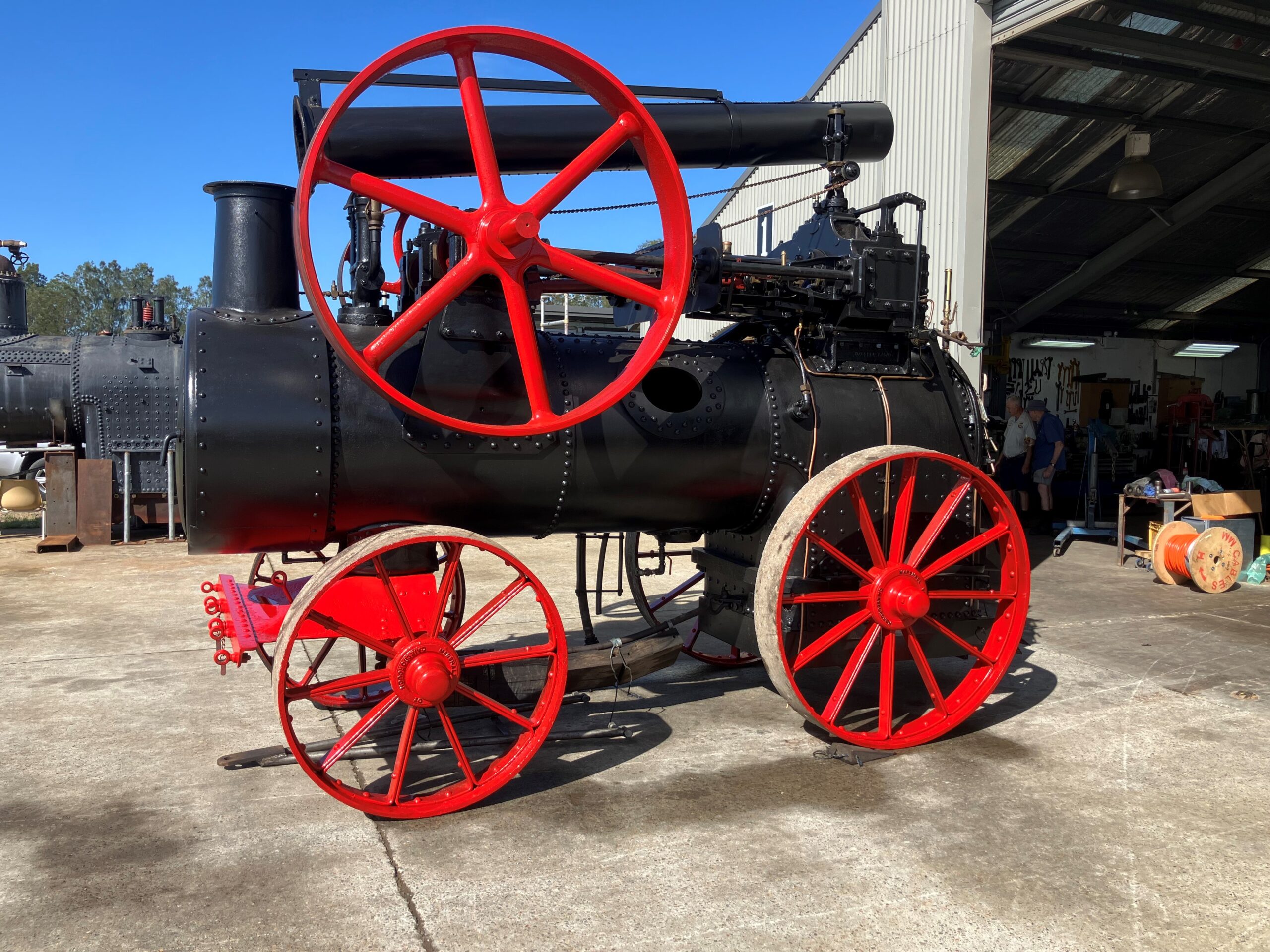
8HP Marshall
Manufacturer: Marshall Sons & Co Ltd
Britannia Iron Works, Gainsborough, England
Year of Manufacture: 1914
Country Assembled In: England
Type of Boiler: Locomotive Type
Fuel Used: Wood
Owned By: Ross Taylor
Location: Tamworth
Restored By: Ross Taylor
History of Ownership: 2017 Ken Kradic sold portable to Ross Taylor 2000 purchased from Stan Williams by Ken Kradic. Purchased by Stan Williams for $200 in 1972 it worked his saw mill from 1972 to 1976. In 1976 it was replaced by a14hp Marshall portable
Description of Use: Used to saw Mill Equipment
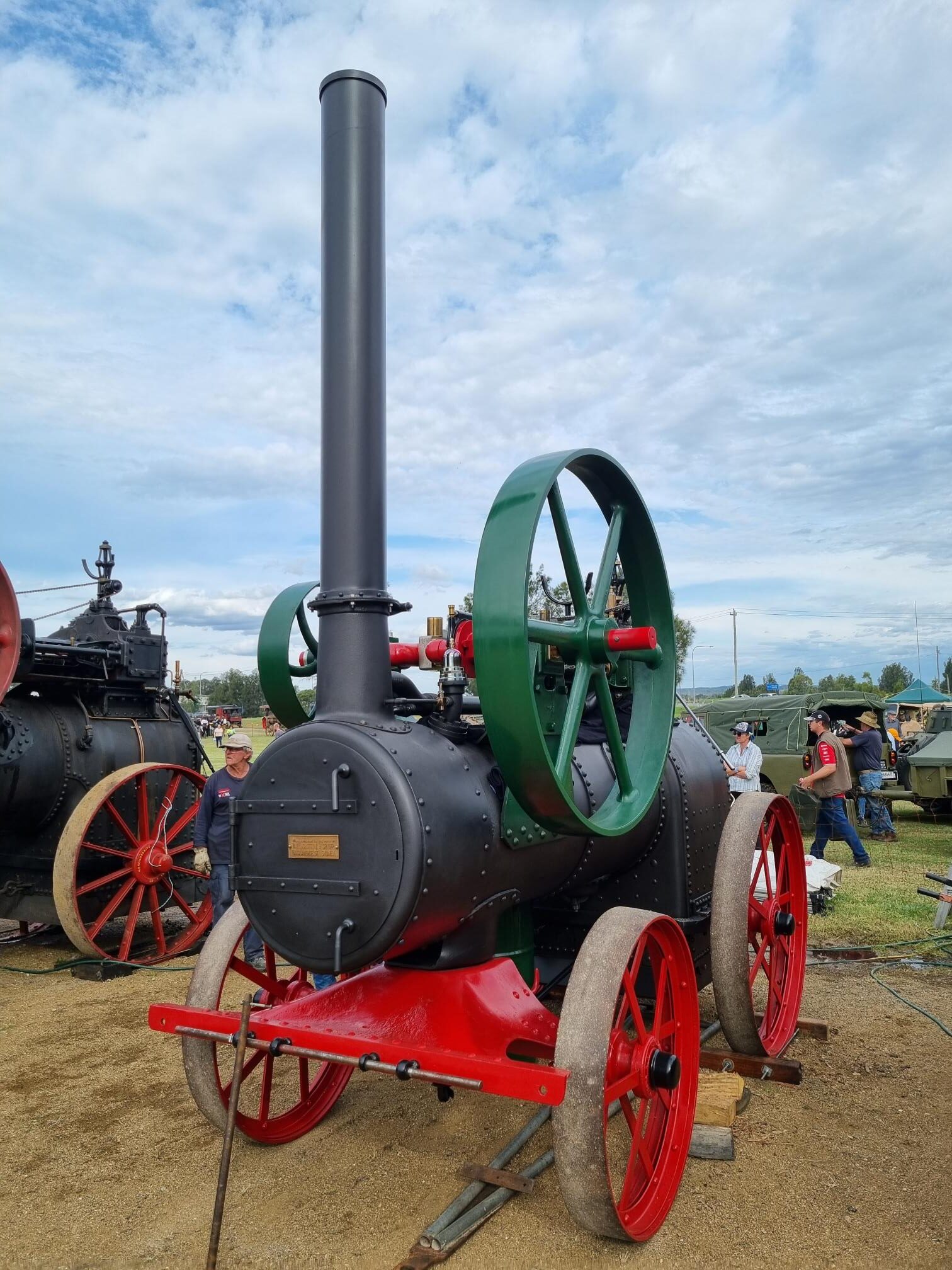
Bill Ives Marshall
Manufacturer: Marshall Sons & Co Ltd
Britannia Iron Works, Gainsborough, England
Year of Manufacture: 1925
Country Assembled In: England
Type of Boiler: Locomotive Type
Fuel Used: Coal or Firewood
Owned By: Bill and Daniel Ives
Location: Brisbane
Restored By: Bob and Bill Ives
Description of Use: Marshall 80161 was built in 1925 and arrived in Australia in February 1926. The Roller was imported for the Queensland Main Roads Commission by the Queensland Machinery Company. The roller was used by main roads in the southeast Queensland area.
The last known job was the Toowoomba range west of Brisbane. It was sold in the early 1960’s to Cyril Cadwallader for preservation. It was subsequently sold to a caravan park builder who used it to build a caravan park at Caboolture. It then went to a private collector and then to a couple of tourist parks.
The last park closed, and the roller again went to a private collector. It wasn’t steamable then and he towed it to roll his driveway with a frontend loader. One day the roller got away and dragged the frontend loader down the road.
Bill bought the roller shortly after that and he and his family have had it running for over 30 years.
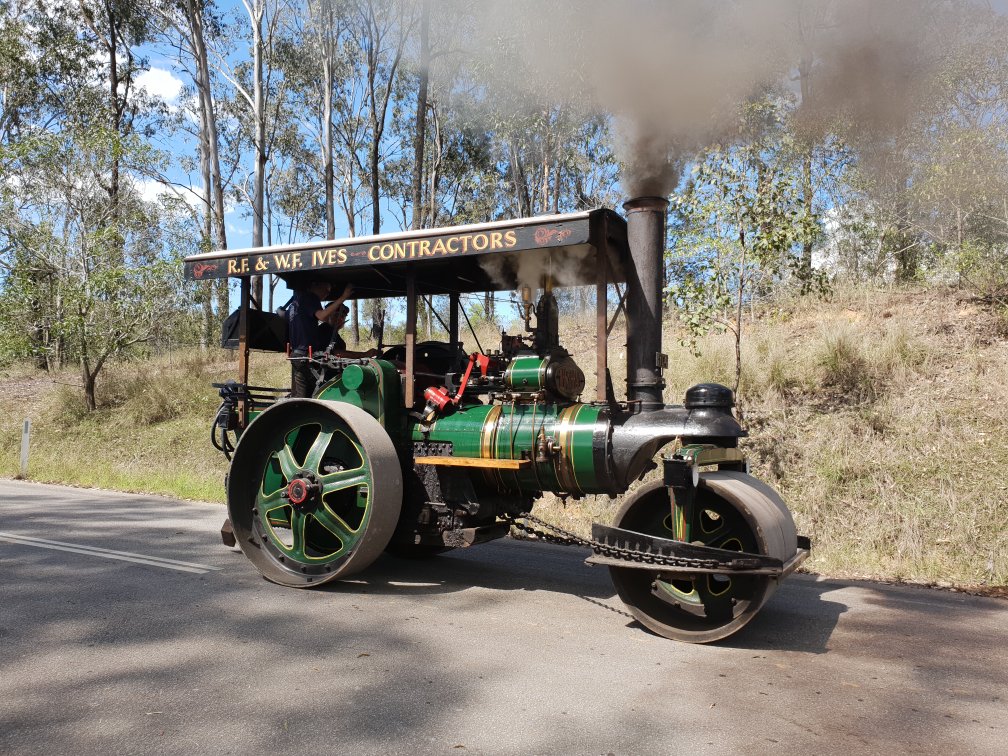
Marshall
Manufacturer: Marshall
Year of Manufacture: 1911
Country Assembled In: England
Type of Boiler: Locomotive
Fuel Used: Wood
Owned By: Jim Hawkes
Location: Maitland
Restored By: Andy Sinclair
History of Ownership: Left Gainsborough work on the 26th July 1911 and shipped tp Scruttons Pty Ltd Sydney. Sold to the underwood family and used to power a sawmill in the Kenebri district NSW Purchased in 1985 by Andy Sinclair and restored.
Used to: Power a Sawmill

Stanley Steamer racing car
Manufacturer: Stanley Twins
Year of Manufacture: 1921
Country Assembled In: USA
Type of Boiler: fire tube
Number of Cylinders: Twin cylinder double acting Cylinder 4’’Bore X 5” Stroke
Fuel Used: Kerosene Main Burner Pilot Burner Sheltie
Fuel tank 15 Gallons
Owned By: John Pryde
Location: Hunter Valley
Restored By: John Pryde 2nd Stanley Steamer He has restored
History of Ownership: Purchased from Janet Holmes a court.
Used to: Steam Power Tourer 7 seater
A full tank of fuel gives 150 to 250 MPG
In 1906 a Stanley Steamer racing car reached a top speed of
127.66 MPH
In1907 the same car tried to better it top speed and crashed at
180 MPH
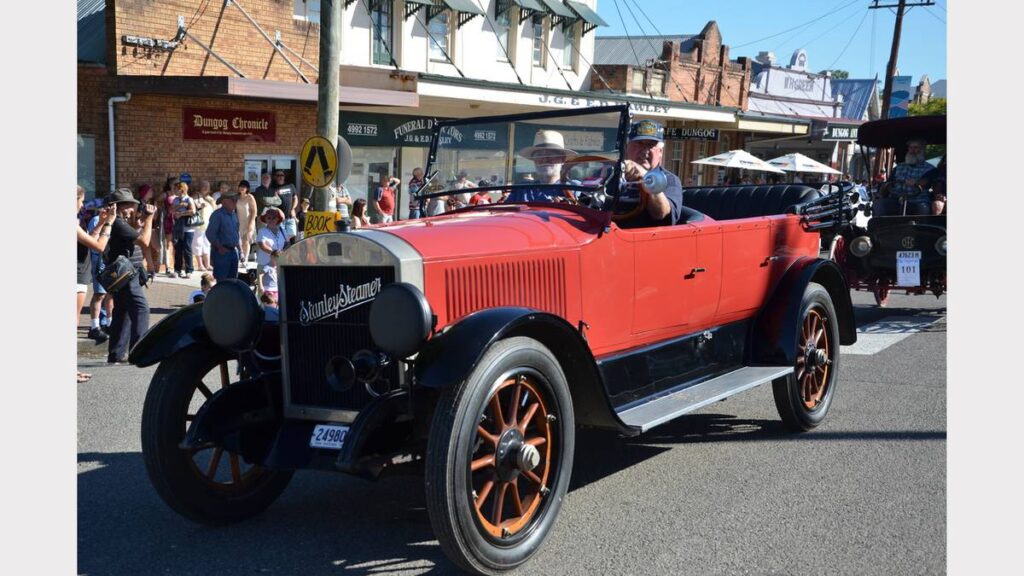
Morris Family - Truck
Manufacturer: Bufflalo Pitts
Year of Manufacture: 1912
Country Assembled In: USA
Type of Boiler: Locomotive
Fuel Used: Wood
Owned By: Alan Simpson
Location: Tamworth
Restored by: Alan Simpson purchased in 1975 restoration completed in 1988.
Used to: The traction engine was used to operate the Upper Horton Mill and attend to yard duties as required.
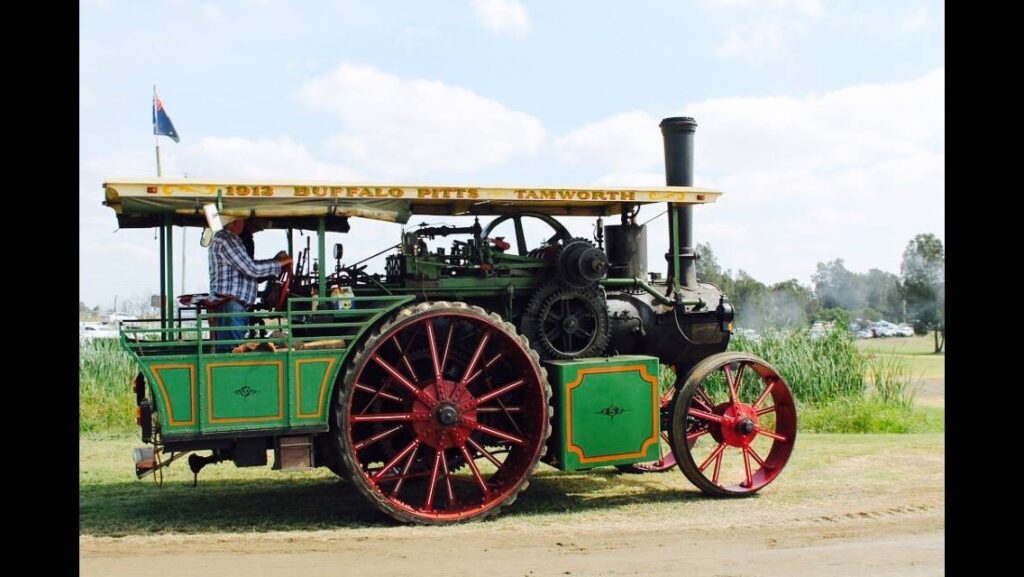
4 HP Marshall
Manufacturer: Marshall
Year of Manufacture: 1911
Manufactures Number: 57264
Country Assembled In: England
Type of Boiler: Locomotive Type
Fuel Used: Wood
Owned By: Jim Hawkes
Location: Maitland NSW
Restored By: Andy Sinclair
History of Ownership: Left Gainsborough work on the 26th July 1911 and shipped tp Scruttons Pty Ltd Sydney. Sold to the underwood family and used to power a sawmill in the Kenebri district NSW Purchased in 1985 by Andy Sinclair and restored.
Used to: Power a Sawmill
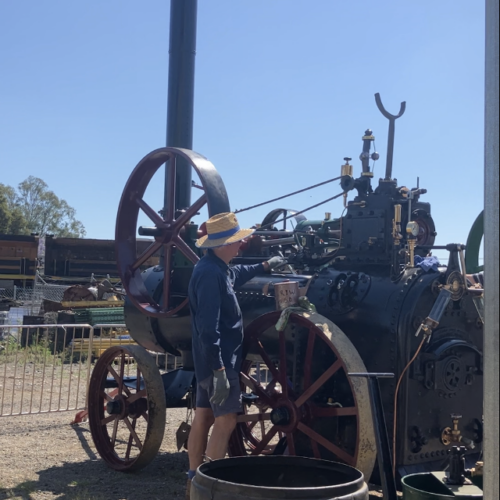
Roby Traction engine GH PM
Manufacturer: Robey
Year of Manufacture: 1924
Manufactures Number: MO 30317, Engine No 41802
Size Nominal Horse Power:10HP
Number of Cylinders: 2
Type of Boiler: Fire Tube
Boiler Pressure: 100
Fuel Used: Wood or Coal
Owned By: Phil Mullins
Location: Wagga Wagga
Restored by: Maintained by Phil Mullins and Geffrey Holgate – has never been restored.
History of Ownership: New to James Dunns in 1924. It was railed to Wagga Wagga and used to cut chaff in the district of Riverina and bring the chaff back to the railhead in Wagga Wagga or warehouse. It all so use to bring timber to the Hardy Bros mill in Wagga and at one stage moved the old hospital to a new site. It ended up at the chaff mill in Henty in 1952 and went with the mill when George Wettern and Co brought the chaff mill in Allan Street, Henty in 1962. Some time later in the 1960’s Allan Pickering came down from Sydney and George gave him the engine to take home to Sydney and restore. So Allan lit a fire in it, intending to stream it to the rail yard in Henty, to train it back to Sydney. Butdastard stuck at 40 pounds when a fire tube blew out, so Allan left the engine in Henty.
In 1983 Brian and his father with the help of Harold Fife fitted a new set of tubes and bottom stays in the firebox. The Robey attended the 1986 Henty Centenary, it first road trip. Brian Wettern had a lot of fun with the Robey attending many a rally and road run with it, such as Yerong Creek Rally and the NHMA National Rally when it was held in Henty.
I meet Brian in 2004, when the Wagga Historic Engine Club was retrieving it’s sister engine from the Botanic Gardens in Wagga Wagga – which is currently being restored by the club.
I then started to help crew the Robey with Brian when it went out to events.
In 2016, Brian decided that it was time to move the Robey on and rang myself to see if I was interested in buying the Robey, as he didn’t want the engine to be scrapped or go overseas or leave the district. It was a once in a lifetime opportunity.
Since then the Robey has been in regular use. It had a few problems. We have replaced the big end bearings; gearing and it use to jump out of gear, which is a little frightening when you have no brakes.
Used to: Chaff cutting and heavy haulage.

Yorkshire Steam Wagon
Manufacturer: Yorkshire Steam Wagon
Year of Manufacture: 1924
Manufactures Number: 2049
Manufactures Number: England
Size Nominal Horse Power:6 NHP
Number of Cylinders: 2 Compound
Type of Boiler: Two pass double ended superheated
Boiler Pressure: Originally 220PSI Currently 180PSI
Fuel Used: Wood or Coal
Owned By: Robert Jones
Location: Melbourne
Restored by: Dave Mickle
History of Ownership: Dave Mickle 1980-2002
Robert Jones 2002-present
Used to: General freight haulage.

Robey & co
Manufacturer: Robey & co
Year of Manufacture: 1923
Manufactures Number: 40902
Size Nominal Horse Power: 4HP
Number of Cylinders: 2 in a Compound arrangement
Type of Boiler: Locomotive/ fire tube.
Boiler Pressure: 120psi
Fuel Used: Coal / wood
Owned By: Sarah Gray, Operated by Son Michael & Grandson Myles
Restored by: Maintained by Phil Mullins and Geffrey Holgate – has never been restored.
History of Ownership: Ordered new for Alexandera / Newtown council & sold after the end of WW2. Believed to be used as a stationary boiler in the Southwestern Sydney for agriculture use. Then made its way south to a property at Balmoral on the Picton – Mittagong loop line.
Saved & initially restored in the 1970’s by the late Benny Rachwal & members of the Colo Vale Steam machinery group. Benny ‘spotted’ roller from the cab of a railway locomotive he was driving and later returned to the property to see about saving the engine.
The engine operated in the 1970’s through to the late 1980’s with Wayne Gray taking on many of the ongoing repairs such as ash pan replacement, boiler tubes and fabrication repairs to the bunker.
The engine was passed down to Sarah Gray from Benny. The roller was out of action from the 1990’s through to the late 2010’s. Michael, Brother John and Wayne spent many hours of work in spare time fully restoring the engine to what you see today.
Latest Restoration work by: Wayne Gray, Michael Gray, John Gray.

JOhn Fowler
Manufacturer: John Fowler
Year of Manufacture: 1922. It left the works for Australia on the 29-4-1922
Manufactures Number: 14676
Country Assembled In: England
Size Nominal Horse Power: 4NHP
Number of Cylinders: 2 Compound
Type of Boiler: Locomotive
Boiler Pressure: 180 PSI
Fuel Used: Coal
Owned By: Stephen Deacon
Restored by: Stephen Deacon
Weight of Engine: 10.5 tons
History of Ownership: Bought new by the BOREE Shire Council at Cudal, NSW. Used for road making around the Boree Shire until the early 1950’s. It was sold to a local man, Arthur Davis who towed a large chaff cutter around the local farms contract chaff cutting. In the early 1960’s was sold to a Mr Fester of Coonabarrabran who tried to use it on his farm but was too heavy for farm soils and was abandoned. Eddie Manglesdorf of Coolamon bought it in the 1970’s but it was so badly worn out he sold it to me, Stephen Deacon on 15-1-1979. I spent 10 years rebuilding it and had its first running to Thirroul public school 100 year celebrations. It was completely dismantled and the boiler was cut up to repair it as it was rusting thin in the inner firebox. It has just returned to operating condition again.

Stephen Deacon C & S
Manufacturer: Clayton & Shuttleworth
Year of Manufacture: 1009
Manufactures Number: 41817
Country Assembled In: England
Size Nominal Horse Power: 4NHP
Number of Cylinders: Single
Type of Boiler: Locomotive Fire tube
Boiler Pressure: 80 PSI
Fuel Used: Timber wood
Owned By: Stephen Deacon
Restored by: Stephen Deacon
Weight of Engine: 3.5 tons
History of Ownership: Imported from England in 1909 through Dalgety
&Co Agents Sydney Work a shearing shed at Werris Creek NSW Purchased in 1970. Went through a few
owners until purchased by Stephen Deacon in 2022. It was restored over a few months.

The Sentinel Wagon Works
Manufacturer:The Sentinel Wagon Works.
They were a British steam wagon and locomotive manufacturer in Shrewsbury, England.
Year of Manufacture: 1924
Manufactures Number: Super Sentinel Steam Wagon No.5322
Country Assembled In: England
Size Nominal Horse Power: 70 HP
Number of Cylinders: Twin-cylinder double-acting
Type of Boiler: Vertical Water Tube Type
Boiler Pressure: 230 PSI
Fuel Used: Coal
Owned By: Paul Dove, Karen Clark and Emily
Location: Bargo, NSW
Restored by: Early restoration by Clarrie Wallis
2013/14 restoration by Paul Dove.
Boiler rebuilt and other mechanical repairs
History of Ownership: Bought new by Ted Flower from agents William Adams & Co. Then Walter Berry of Trundle, then Bob McLeod of Cowra, then Clarrie Wallis of Kogarah then Paul Dove of Bargo.
Description and Use: It was used to deliver brown coal around Melbourne before being bought and driven to Trundle, NSW in 1939 to use on the Berry family farm ‘Woodview’ to deliver bagged wheat to the railhead.
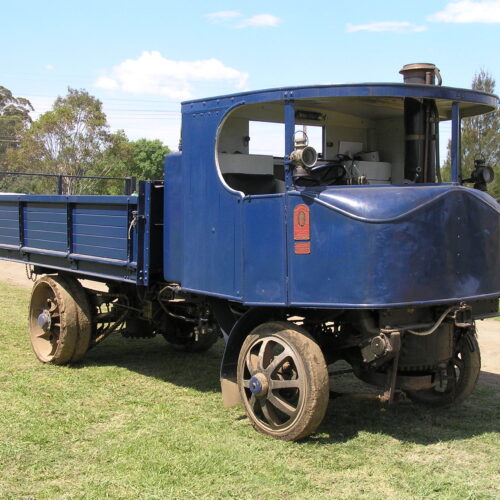
On site demonstrations:
A Buffalo Pits portable steam engine will be driving a saw bench cutting up timber Supply the wood for the Clayton & Shuttleworth portable steam engine
The Clayton & Shuttleworth portable steam engine will be driving a power generator The power generated will be used to charge a Tesla electric Car
